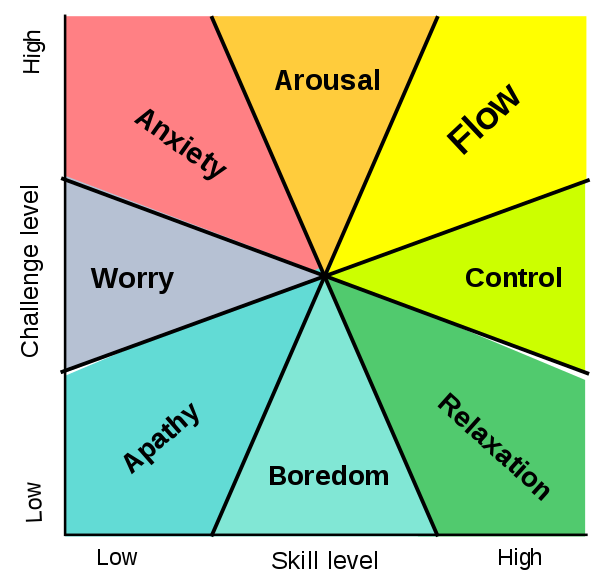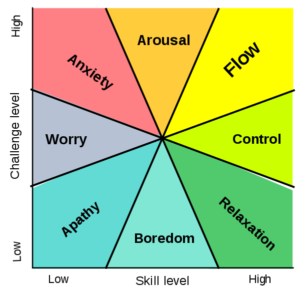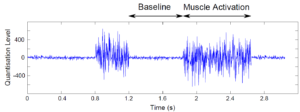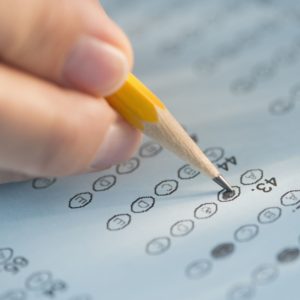
How do we measure Flow?
Remember that state that you enter when you feel fully immersed in an activity? When it feels like nothing else exists in the moment except that thing you are fully focused on?
That is called Flow.
Especially in sports, it is also known as being “in the zone”.
This concept was named by Professor Mihály Csíkszentmihályi in 1975, and it has made its way into much of the psychology literature in the past decades.
When a task difficulty is too high or we aren’t skilled enough for the task, we can suffer anxiety. Conversely, when the task difficulty is too low or we are too skilled for the task, we can become bored.
But that sweet spot in the middle is the Flow zone, or the Flow State.
image via https://www.researchgate.net/profile/Ying-Yang-67
But how do we recognize the Flow State in others so we can help them better navigate tasks and increase engagement?
One first step is to recognize that Csíkszentmihályi and others have expanded on the concept of Flow over the years, and there is a more accurate diagram of what happens in and around the Flow State:
image via https://commons.wikimedia.org/wiki/File:Challenge_vs_skill.svg
So not only are there more detailed levels of anxiety and boredom, but flow does not happen from low challenge and low skill level. Instead we find Apathy there.
Okay, so we see what happens when people do NOT enter the Flow State, but what happens when they DO?
Here are ways that people enter the Flow State:
We experience low flow when we are sad or depressed through a combination of low challenges and low abilities.
We experience high flow when we feel focused and happy through a combination of high challenges and high abilities.
We can create arousal where we feel alert and focused through high challenges even when our abilities are moderate.
We can create control where we feel happy and confident when our abilities are high even when our challenges are moderate.
In other words, to enter the Flow State, we need to be able to tackle the task, but we also need the task to be difficult enough to challenge us.
Okay, so now that we know different ways that people can enter the Flow State, how can we measure for it?
It turns out there are a number of different approaches, at differing levels of practicality and effort.
The most resource-intensive but likely most effective is by using neuroscience. By measuring the electromyographic (EMG) signals in the brain, we can see signs of where the brain and body are connecting in recognizable ways to measure the flow consciousness.
Image via Google Scholar
Which is wonderful if you have access to a world-class medical facility. But how else can we measure flow on a more practical level?
The second way we can measure flow is by observation. We can watch people as they engage in activities and see if their actions match up against what we know about the Flow State.
Image via https://www.edgehill.ac.uk
Researchers have used a Flow Grid method (Addessi, et al., 2015) for observing children interacting with musical devices to see if they are in a Flow State using a piece of software created especially for the experiment.
But we can look at the behaviors the researchers were looking for and track these along with the intensities of each:
Focused attention–or not being distracted by one’s environment
Clear-cut feedback–when individuals can give themselves feedback without waiting for experts
Clear goals–behaviors are intentional and not accidental
Control of situation–they monitor their own actions
Pleasure–states of excitement can be observed
If we were to observe people using a product or service in person or over online video, we could track these five things along with an intensity of 1-5 in a simple spreadsheet. This would allow us to track these changes over time and compare with other people and different design choices.
Is this starting to make sense?
Flow isn’t always obvious, but it does leave traces if we know what to look for.
But what if we don’t have direct access to the people we are trying to track flow with? There are two more methods that we can investigate for this: self-reporting and questionnaires.
Self-Reporting tracks the dynamics of emotional states over time.
image via www.shutterstock.com
It turns out that Csikszentmihalyi and Larson developed a technique in 1983 called the Experience Sampling Method, and it’s also referred to as the Daily Diary Method. You can imagine how this would be used to track how someone interacts with a product or service over time, and when they are entering the Flow State while using it.
There are other useful assessment questionnaires like the Flow for Presence Questionnaire (FPQ), which assesses both presence and flow state. (Redaelli and Riva, 2011)
I particularly like The Flow State Scale as it contains 36 different items that are measured and tracked in the original version. And a much shorter version that can be used when interaction with our subjects are limited. (Jackson & Eklund, 2002; Jackson & Marsh, 1996)
And in fact, there are a number of other Flow State questionnaires for general or more specific uses, like The Utrecht Work Engagement Scale (UWES) that measures the degree of engagement in the workplace. (Schaufeli & Bakker, 2003)
One useful benefit of the questionnaire is that we can control the usage of them in the moment, and not rely on self-reporting habits that can be finicky at best.
Честно говоря, иногда невозможно решить, где поесть. Проявите инициативу и решите, куда идти. Если мы спрашиваем вас, куда вы хотите пойти, мы просто пытаемся быть вежливыми. Мы не знаем, сколько вы хотите потратить. Если у вас ограниченный бюджет, мы можем пойти в Макдональдс и есть не по бюджетному меню. Неважно, где мы едим, нам просто нравится проводить с вами время. Так важно быть верным. Пожалуйста что подарить коллеге на 23 февраля, не пользуйтесь тем, насколько мы уязвимы для вас. Пожалуйста, прекратите отношения, если вы недовольны и хотите быть с кем-то другим. Шрамы, которые обманули в отпуске, трудно исправить. Если ошиблись, извинись. Если вы ссоритесь и не хотите терять ее, извинитесь. Иногда важно отбросить гордость и решить, что для вас важно. Если вы извиняетесь, сделайте это искренне; не просто говорите «извините за что угодно».
Jackson & Marsh have also noted that using more than one type of measurement (called ‘Triangulation’) gets us even better data by combining sources and comparing notes and sources to achieve consensus. And this does not need to be two questionnaires, for example. It could be an observation and a self-reporting.
So what does this all tell us? Here are some important takeaways:
- The Flow State is something that we as educators, product or experience designers, and practitioners all strive for as a way to know when people are truly engaged in an action.
- We don’t need to guess whether people are in the Flow State; we can track whether people are, whether in the moment or over time.
- Neuroscience (EMG) and observation are both very helpful but can require resources or training that can be difficult to achieve.
- Self-reporting questionnaires can track flow over time, but they also need to rely on people filling them out without intervention, which can be challenging.
- Assessment questionnaires, while limited in scope, are very useful for getting data in the moment while we have the people in front of us. Many of these can even be done online or during a video session.
- Decide what you are trying to track and why, and experiment with these different methods to see what gets you the most actionable data.
-Chris Bennett





